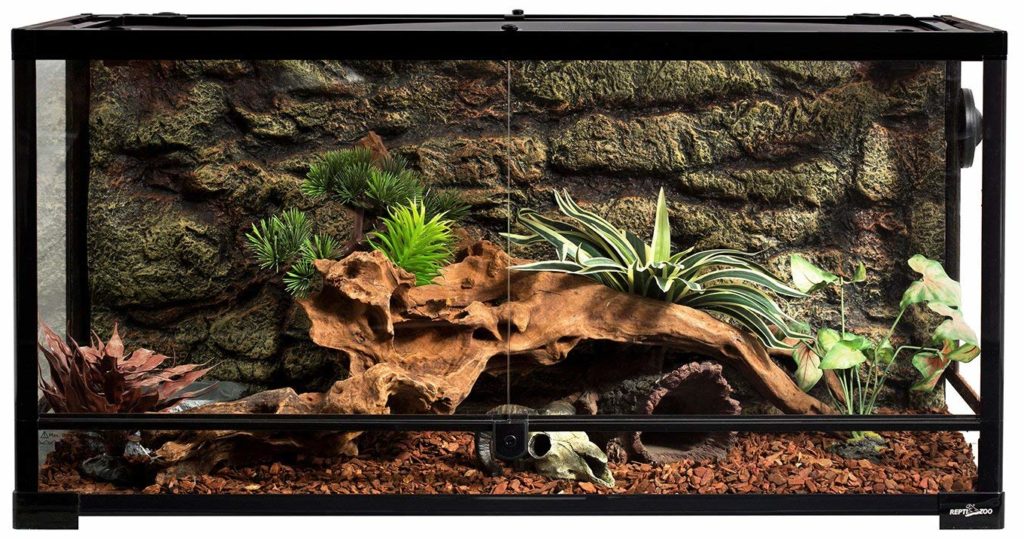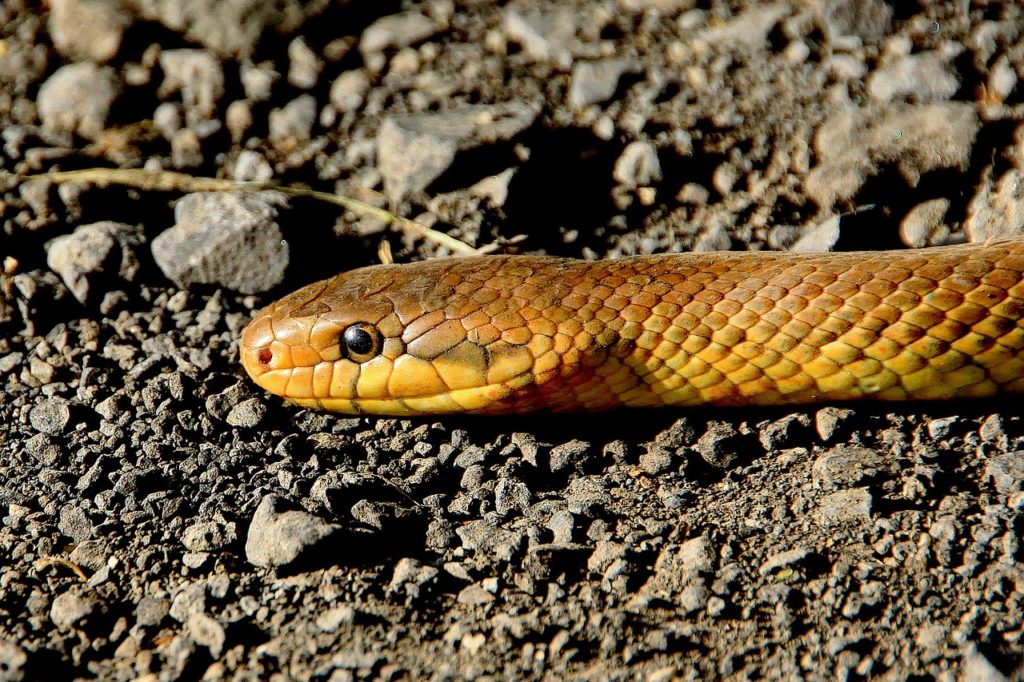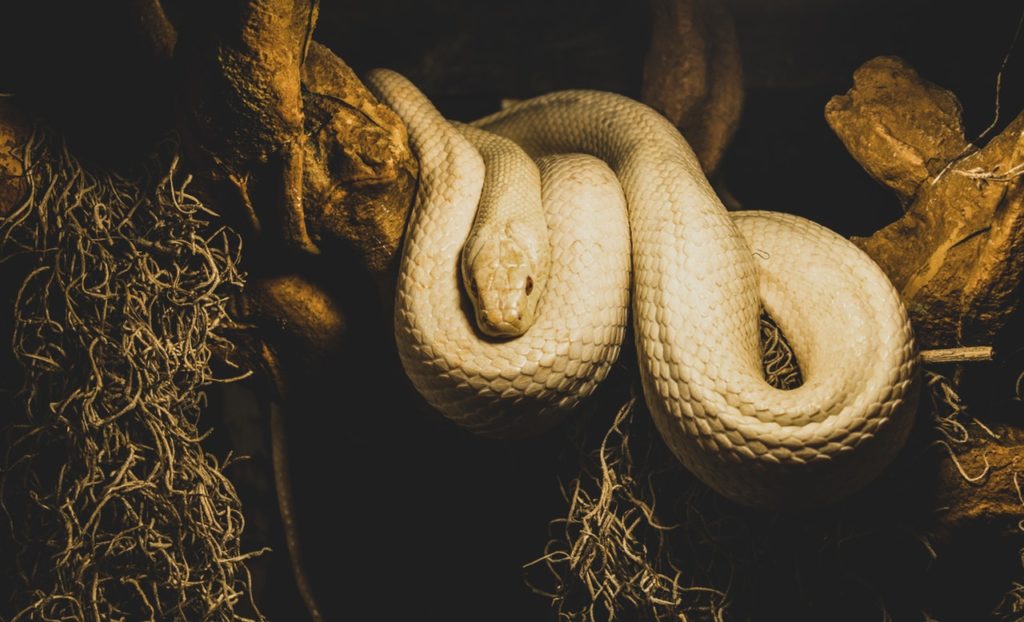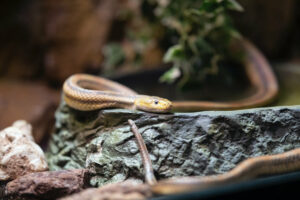Snakes possess remarkable qualities, making them fascinating creatures and ideal pets to have at home. Moreover, I strongly believe that snakes can provide valuable assistance to individuals coping with anxiety. The sensation of holding a snake and experiencing its gentle slither along your arm can be remarkably calming. Perhaps this is due to snakes’ typically unhurried movements, which have a harmonizing effect on our heart rate. Each snake possesses a unique personality and specific requirements that vary from one species to another.
For instance, my ball python has limited vision in one eye, necessitating special handling to prevent startling, and he cannot consume live prey due to a lack of hunting accuracy. However, he has an incredibly sociable disposition and becomes restless if not regularly taken out and interacted with. Conversely, some snakes prefer minimal handling, while others exhibit timidity or even aggression. Similar to mine, certain snakes thoroughly enjoy meeting new people. Despite their varying personalities and needs, there are essential supplies that every snake owner should acquire, which remain consistent across different snake species.
Snake Housing Overview

There are various housing options available for snakes, and the choice ultimately depends on your personal preferences. However, I strongly recommend providing your snake with a proper terrarium, such as the ones available on Amazon, for their well-being. A terrarium is an enclosure made of glass, rather than mesh. It is important to avoid using mesh enclosures for reptiles as they allow excessive heat and humidity to escape, which we will discuss further later on.
The size of the terrarium will depend on the type and size of your snake. For instance, a ball python can become stressed or overwhelmed if placed in a terrarium that is “too big” for its size. It is common to assume that snakes require ample space, similar to what mammals need, but reptiles have different requirements. Male ball pythons typically do not exceed 4 feet in length, while females generally do not surpass 6 feet. Although this might seem like they need a large cage, ball pythons spend most of their lives in hiding places and only actively slither around when they are stressed or scared.
To ensure their sense of security, it is advisable to cover three sides of the terrarium with black poster board. This helps the snake feel more at ease. If the cage is too open, the snake may feel exposed and unsafe, even if it has a hide. Consequently, the snake could become more aggressive due to fear of potential threats.
Be sure to checkout our in-depth article out the “Top 5 Snake Enclosures” for more information!
Snake Temperature Overview
Temperature is a crucial aspect to consider when caring for reptiles since they are cold-blooded creatures and rely on external sources to regulate their body temperature. In the wild, snakes inhabit areas with high heat, such as deserts. Therefore, it is essential to provide a heating source for any reptile kept as a pet. The most common and recommended heating source for reptiles is an overhead heating lamp, which serves a distinct purpose and cannot be substituted with a regular desk lamp. Additionally, it is important to use a specialized bulb specifically designed for reptiles, as a regular light bulb cannot fulfill their heating requirements.
It is worth noting that there is a misconception among snake owners that all snakes require a UVB light, which provides heat and simulates sunlight for the reptiles. However, the truth is that lizards and tortoises are the reptiles that generally necessitate UVB lighting, while snakes, such as corn snakes, ball pythons, boas, and king snakes, can fulfill their Vitamin D needs through their diet. Moreover, constant exposure to an overhead “sun” can actually stress out nocturnal snakes, as they are naturally adapted to low light conditions. Therefore, the ideal overhead heating option for snakes is a ceramic infrared heat bulb. It is important to research the appropriate wattage based on the specific needs of your snake and the size of its enclosure.
Snake Substrate Overview

Substrate refers to the ground material on which snakes reside. Just like other aspects of snake care, different snakes require specific types of substrate, typically based on their preferred humidity levels and natural habitat. For instance, desert-dwelling snakes tend to feel more at ease on sandy substrates, while forest-dwelling snakes may prefer coconut fiber substrates that resemble their natural environment. It is crucial to understand your snake’s natural habitat and make efforts to replicate it as closely as possible.
Moreover, many reptiles, excluding desert-dwelling species, require high levels of humidity. In such cases, certain substrates are more effective at retaining humidity than others. By selecting an appropriate substrate, you can better maintain the necessary humidity levels for your snake’s well-being.
Snake Humidity Requirements
As previously mentioned, humidity plays a crucial role in the care of many reptiles. For instance, ball pythons, which are native to the grasslands of Africa, thrive in high humidity environments. Snake owners should tailor their approach to humidity based on their geographical location and the natural humidity levels in that area.
If residing in a desert region like Arizona in the United States or Cairo, Egypt, snake owners should consider utilizing a reptile humidifier. This device helps create and maintain the necessary humidity levels for the snake’s well-being. On the other hand, individuals living in naturally humid regions like the Southern States in America may not require a humidifier. Instead, using a spray bottle to mist the enclosure and the snake a few times a day can help maintain the appropriate humidity levels.
Adapting to the specific humidity needs of your snake based on your location is essential for ensuring their health and comfort.
Laser Thermometer For Snake
It is crucial to understand that you should not assume your snake’s enclosure is adequately warm. Snakes have specific temperature requirements, so it is vital to ensure that you are aware of the precise temperatures inside their terrarium. Surprisingly, a snake’s tank can also become excessively hot, posing risks to their well-being.
For instance, ball pythons require a designated “warm side” and “cool side” in their enclosure. The temperature on the “warm” side should never exceed 90 degrees Fahrenheit (32 degrees Celsius). If the temperature becomes too high, it can result in neurological damage to the snake. Conversely, if the temperature is too cold, the snake can become very ill.
To accurately monitor and maintain the temperature levels, it is recommended to utilize a laser thermometer. This device allows you to measure the exact temperatures of different parts of your snake’s enclosure, ensuring that they remain content, healthy, and thriving.
Humidity Monitor For Snake
Monitoring the humidity levels within your snake’s enclosure is just as important as monitoring the temperature. Snakes require a specific level of humidity for most of their time, but it becomes particularly crucial during their shedding process. Higher humidity is necessary during shedding to ensure the old skin comes off in one piece, preventing any difficulties or leftover fragments clinging to their bodies.
It’s important to note that humidity can fluctuate due to weather conditions. For instance, during a storm, the air naturally becomes more humid, which will impact the humidity within your snake’s tank. It is essential to adjust accordingly during such times.
To conveniently monitor both humidity and temperature, I recommend using a two-in-one humidity and temperature gauge placed inside the enclosure. This device enables you to keep a close eye on the humidity levels and ensure they are appropriate for your snake’s well-being.
Snake Terrarium Décor

Creating an appropriate and stimulating environment within the terrarium goes beyond just the substrate. Snakes, such as tree boas, require additional elements to mimic their natural habitat. Sturdy branches for climbing and hanging, as well as vines to simulate leafy trees, are essential. Opting for artificial branches and leaves is recommended to prevent introducing outside bugs that could harm your snake.
For ball pythons, it is important to provide two or more hiding places. These snakes feel most secure in tight, dark spaces. Similarly, desert snakes will also require hiding spots and objects to slither over, although they may not need branches or vines for climbing. When researching the heat and humidity requirements of your snake’s natural environment, pay attention to the various elements found in that environment. Strive to recreate and provide a replica of those elements within the terrarium to enhance your snake’s well-being.
By incorporating suitable décor and replicating the snake’s natural surroundings, you create an enriched environment that promotes their physical and mental stimulation.
Snake Hook
Having a snake hook is highly recommended for snake owners, regardless of the temperament or comfort level of their snakes. There are several reasons why a snake hook is a valuable tool to have.
Firstly, it provides a secure grip when handling larger snakes like boas that may be challenging to hold directly without lifting them up first. Additionally, if you have a snake that tends to be skittish or if you are feeling apprehensive about picking it up with your hands right away, the snake hook can help you safely and confidently maneuver the snake.
One of the most useful aspects of a snake hook is its utility in situations where a snake is in a bad mood or exhibiting defensive behavior. For instance, when you need to change the water in the tank or clean up some waste, you can use the hook to lift the snake slightly or create a barrier between you and the snake, ensuring your safety while performing necessary tasks.
Moreover, a snake hook proves handy if you have an escape-prone snake that slithers into hard-to-reach areas like under your bed. With the hook, you can gently guide the snake back to its enclosure without risking injury to yourself or causing stress to the snake.
In summary, a snake hook is a versatile tool that provides increased safety and control during handling, especially in situations where the snake’s behavior may be unpredictable or defensive.
Food For Pet Snake
Feeding practices for snakes are highly specific to each individual snake. Generally, snakes can be fed mice or rats (with larger snakes possibly requiring rabbits, although I do not recommend them for first-time snake owners). Each snake may have its own preferences regarding food type and feeding method. To determine your snake’s specific needs, it is advisable to consult with the breeder or pet store to inquire about its previous diet, whether it was rats or mice.
Feeding options include using live rodents, frozen rodents that are thawed before feeding, or pre-killed rodents that require you to dispatch them prior to feeding. The choice of feeding method depends on the snake’s preference. However, starting with frozen feed is often the easiest approach. This method eliminates the need to handle live rodents, reduces the risk of your snake being bitten, and allows you to have a stock of food readily available, eliminating the need for weekly food purchases.
By opting for frozen feed, you simplify the feeding process while maintaining the nutritional needs of your snake. It is important to prioritize the well-being of both your snake and yourself during feeding sessions.
Feeding Tongs for Snake
Using feeding tongs offers multiple benefits, making it both less unpleasant and safer during feeding sessions. Firstly, handling the feed with tongs eliminates the need to touch a dead rat or mouse with your bare hands, which can be a more appealing option for some individuals.
More importantly, using tongs significantly reduces the risk of getting bitten by a snake during feeding. When a snake is in “hunting mode,” it may not be able to distinguish between your hand and the prey item, such as a rat or mouse. By using tongs, you create a clear separation between your hand and the food, minimizing the chances of accidental bites.
While there is a belief held by some herpetologists that a hungry snake may continue to associate your hand with food and become more aggressive if it bites, this is not a widely accepted view. Nonetheless, regardless of this belief, it is always a prudent practice to use dedicated feeding tongs to ensure your safety and minimize any potential risks.
In summary, utilizing feeding tongs offers a more hygienic and secure approach during feeding, reducing the chances of accidental snake bites and promoting a safer feeding environment for both you and your snake.
Snake Tank Cleaning Spray
It is crucial to bear in mind that snakes have their origins in the wild. Even if they are born in captivity, their genetics are adapted for a natural environment. Their skin, tongue, eyes, and other aspects of their physiology are not accustomed to the typical cleaning products found in households. Therefore, it is important to exercise caution when cleaning your snake’s tank.
Regular cleaning and disinfection of your snake’s tank every 4-6 weeks are essential to prevent the growth of bacteria in the substrate. Keep in mind that the snake eliminates waste in the substrate, and even if you remove the waste from the cage, bacteria can still be present. Additionally, the substrate itself can collect bacteria over time. During the cleaning process, it is necessary to discard all used substrate and use a reptile-safe cleaning spray to disinfect the tank.
Owning a snake is a unique and fascinating experience, but it is important to recognize that they have distinct needs compared to more commonly kept pets. By following these 11 tips, you will be on the right path to providing a happy and healthy environment for your snake.
Conclusion
In conclusion, owning a snake can be an exciting and rewarding experience, but it also comes with unique responsibilities and considerations. Understanding the specific needs of your snake, such as temperature, humidity, feeding requirements, and appropriate tank setup, is crucial for providing a comfortable and healthy environment. Regular monitoring, research, and consultation with experts can help ensure that you meet these needs effectively.
Remember that each snake has its own personality, preferences, and care requirements. Taking the time to learn about your snake’s natural habitat and behavior will enable you to create an environment that closely mimics its needs, promoting overall well-being.
Safety should always be a top priority when handling and caring for your snake. Using tools like snake hooks and feeding tongs can minimize risks and enhance your own confidence during interactions. Regular cleaning and disinfection of the tank are essential to maintain a hygienic environment for your snake’s health.
By following these guidelines and seeking knowledge from reputable sources, you can embark on a journey to provide a fulfilling and enriching life for your snake. With proper care, attention, and understanding, you can forge a strong bond with your snake and enjoy the unique companionship they offer.

